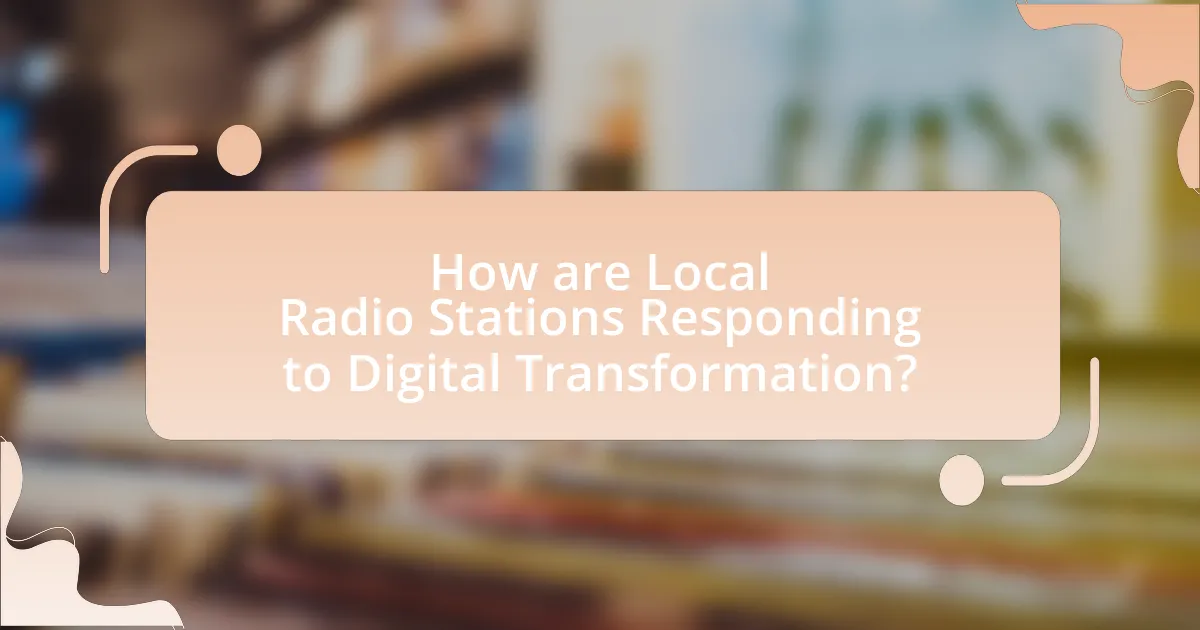Local radio stations are adapting to the digital age by integrating online streaming, enhancing social media engagement, and adopting podcasting to reach wider audiences and compete with digital platforms. Despite facing challenges such as declining advertising revenues and changing listener habits, local stations are implementing strategies to maintain relevance, including diversifying content and utilizing analytics for programming decisions. The article explores the impact of technological advancements, the role of social media, and the importance of community engagement in ensuring the future viability of local radio stations in a rapidly evolving media landscape.

How are Local Radio Stations Responding to Digital Transformation?
Local radio stations are responding to digital transformation by integrating online streaming, enhancing social media engagement, and adopting podcasting. These strategies allow them to reach broader audiences and compete with digital platforms. For instance, according to a 2022 report by the Pew Research Center, 61% of local radio stations have developed online streaming services to attract listeners who prefer digital access. Additionally, many stations are utilizing social media platforms to interact with their audience in real-time, which has been shown to increase listener loyalty and engagement. Furthermore, the rise of podcasting has prompted local stations to create on-demand content, catering to the growing demand for flexible listening options.
What challenges do local radio stations face in the digital age?
Local radio stations face significant challenges in the digital age, primarily due to competition from online streaming services and changing listener habits. The rise of platforms like Spotify and Apple Music has led to a decline in traditional radio listenership, with a 2021 Nielsen report indicating that 63% of Americans aged 18-34 prefer streaming music over radio. Additionally, local stations struggle with limited advertising revenue as advertisers shift their budgets to digital platforms, which offer targeted advertising options. This financial strain hampers their ability to invest in technology and content that could attract and retain listeners. Furthermore, the need to maintain a strong online presence and engage with audiences through social media adds to the operational complexities for local radio stations.
How has listener behavior changed with the rise of digital media?
Listener behavior has shifted significantly with the rise of digital media, leading to increased consumption of on-demand content and a decline in traditional radio listenership. According to a Nielsen report, in 2021, 66% of Americans aged 18-34 preferred streaming services over traditional radio, indicating a clear preference for personalized and accessible audio experiences. Additionally, the availability of podcasts and music streaming platforms has allowed listeners to curate their own content, resulting in shorter attention spans for traditional radio broadcasts. This change in behavior reflects a broader trend towards digital engagement, where listeners prioritize convenience and control over their audio consumption.
What financial pressures are local radio stations experiencing?
Local radio stations are experiencing significant financial pressures primarily due to declining advertising revenues and increased competition from digital platforms. According to a report by the Pew Research Center, local radio ad revenues have decreased by approximately 20% over the past decade, as advertisers shift their budgets to online and social media channels. Additionally, the rise of streaming services and podcasts has intensified competition, further straining the financial viability of traditional radio. These factors collectively challenge local radio stations to adapt their business models to survive in the evolving media landscape.
What strategies are local radio stations implementing to adapt?
Local radio stations are implementing strategies such as enhancing digital presence, diversifying content, and engaging with audiences through social media to adapt to the digital age. By establishing robust online platforms, these stations can reach wider audiences beyond traditional broadcasting. Additionally, they are creating varied programming, including podcasts and on-demand content, to cater to changing listener preferences. Engaging with listeners via social media platforms allows for real-time interaction and feedback, fostering a community around the station. These strategies are essential for maintaining relevance and competitiveness in an increasingly digital landscape.
How are local radio stations enhancing their online presence?
Local radio stations are enhancing their online presence by developing robust digital platforms, including websites and mobile apps, that facilitate streaming and on-demand content access. These platforms allow listeners to engage with live broadcasts, access archived shows, and interact through social media channels. According to a 2022 Nielsen report, 63% of radio listeners engage with stations online, highlighting the importance of a strong digital footprint. Additionally, local stations are utilizing targeted social media advertising and content marketing strategies to reach broader audiences, thereby increasing listener engagement and loyalty.
What role does social media play in the adaptation of local radio stations?
Social media plays a crucial role in the adaptation of local radio stations by enhancing audience engagement and expanding their reach. Local radio stations utilize platforms like Facebook, Twitter, and Instagram to interact with listeners, share content, and promote events, which helps them maintain relevance in a digital landscape. For instance, a study by the Pew Research Center found that 62% of adults in the U.S. use social media, indicating a significant audience that local radio stations can tap into for listener feedback and community building. This integration of social media allows local stations to not only broadcast their content but also create a two-way communication channel, fostering a loyal listener base and attracting new audiences.

What technological advancements are influencing local radio stations?
Technological advancements such as digital broadcasting, streaming services, and social media integration are significantly influencing local radio stations. Digital broadcasting allows for higher sound quality and more efficient use of bandwidth, enabling stations to reach wider audiences. Streaming services provide on-demand access to content, allowing listeners to tune in anytime, which increases engagement. Additionally, social media integration facilitates real-time interaction with audiences, enhancing listener loyalty and expanding reach. These advancements collectively enable local radio stations to adapt to changing consumer preferences and compete with digital platforms effectively.
How are streaming services impacting local radio broadcasting?
Streaming services are significantly impacting local radio broadcasting by diverting audiences and advertising revenue away from traditional radio. As listeners increasingly prefer on-demand content and personalized playlists offered by platforms like Spotify and Apple Music, local radio stations face declining listener numbers. According to a 2021 Nielsen report, 63% of Americans aged 18-34 listen to streaming services weekly, compared to only 36% who tune into AM/FM radio. This shift has forced local radio stations to adapt by enhancing their digital presence, offering online streaming, and creating unique content to retain and attract listeners.
What are the benefits of adopting streaming technology for local stations?
Adopting streaming technology provides local stations with increased audience reach and engagement. By utilizing streaming, local stations can broadcast their content online, allowing them to connect with listeners beyond their traditional geographic limitations. This expanded reach is supported by statistics indicating that over 50% of Americans listen to online radio weekly, demonstrating a significant shift in listening habits. Additionally, streaming technology enables local stations to offer on-demand content, enhancing listener convenience and satisfaction. This adaptability not only attracts a broader audience but also fosters community interaction through real-time feedback and social media integration, ultimately strengthening the station’s local presence and relevance in the digital age.
How do local radio stations integrate podcasts into their offerings?
Local radio stations integrate podcasts into their offerings by creating original content that complements their on-air programming and distributing it through various digital platforms. This strategy allows them to reach a broader audience, as podcasts can be accessed on-demand, catering to listeners’ preferences for flexibility. For instance, many stations produce podcasts that feature interviews with local personalities, discussions on community issues, or highlights from their radio shows, thereby enhancing listener engagement and loyalty. According to a 2022 report by Edison Research, 41% of Americans aged 12 and older have listened to a podcast in the past month, indicating a growing audience that local radio stations can tap into by offering podcast content.
What tools are local radio stations using to engage audiences?
Local radio stations are using social media platforms, mobile apps, and interactive websites to engage audiences. Social media allows stations to share content, interact with listeners, and promote events in real-time, enhancing community connection. Mobile apps provide listeners with on-the-go access to live broadcasts, podcasts, and exclusive content, fostering a more personalized experience. Interactive websites often feature listener polls, contests, and feedback forms, encouraging audience participation and creating a sense of involvement. These tools collectively help local radio stations maintain relevance and strengthen listener loyalty in the digital age.
How do analytics and data influence programming decisions?
Analytics and data significantly influence programming decisions by providing insights into audience preferences and behaviors. Local radio stations utilize listener metrics, such as ratings and demographic data, to tailor their content and programming schedules. For instance, a study by Nielsen found that stations that analyze listener data can increase their audience engagement by up to 30%, leading to higher advertising revenues. By leveraging analytics, radio stations can identify peak listening times, popular music genres, and effective promotional strategies, ensuring that their programming aligns with listener interests and maximizes reach.
What interactive technologies are being utilized by local radio stations?
Local radio stations are utilizing interactive technologies such as social media integration, mobile applications, and live streaming platforms. Social media platforms like Facebook and Twitter allow stations to engage listeners in real-time, facilitating audience interaction through comments and shares. Mobile applications enable listeners to access live broadcasts, podcasts, and station updates, enhancing user experience and engagement. Live streaming platforms provide an avenue for stations to reach broader audiences beyond traditional broadcasting, allowing for interactive features like listener polls and live chats during shows. These technologies collectively enhance listener engagement and adapt local radio stations to the evolving digital landscape.

What are the future prospects for local radio stations in the digital landscape?
Local radio stations have promising future prospects in the digital landscape by leveraging online streaming, social media engagement, and targeted advertising. As of 2023, over 50% of Americans listen to online radio, indicating a shift in consumer behavior that local stations can capitalize on. By integrating digital platforms, local radio can reach broader audiences, enhance listener interaction, and provide personalized content, which is essential in a competitive media environment. Furthermore, the ability to gather data on listener preferences allows for more effective advertising strategies, increasing revenue potential. This adaptability to digital trends positions local radio stations favorably for sustained relevance and growth.
How can local radio stations remain relevant in a digital-first world?
Local radio stations can remain relevant in a digital-first world by embracing digital platforms and enhancing community engagement. By utilizing social media, streaming services, and mobile apps, these stations can reach broader audiences and provide on-demand content. For instance, according to a 2021 Nielsen report, 62% of Americans listen to online radio, indicating a significant shift towards digital consumption. Additionally, local radio stations can focus on hyper-local content that addresses community needs and interests, fostering a loyal listener base. Engaging with audiences through interactive features, such as live chats and social media polls, can further strengthen their relevance in the digital landscape.
What partnerships can local radio stations explore to enhance their reach?
Local radio stations can explore partnerships with digital platforms, local businesses, and community organizations to enhance their reach. Collaborating with digital platforms like streaming services or social media can help radio stations tap into online audiences, as evidenced by a 2021 Nielsen report showing that 62% of Americans listen to online radio. Partnering with local businesses allows for cross-promotional opportunities, increasing visibility in the community. Additionally, working with community organizations can foster local engagement and attract new listeners, as community-driven content often resonates more with audiences.
How can local radio stations leverage community engagement for growth?
Local radio stations can leverage community engagement for growth by actively involving listeners in programming and events, which fosters loyalty and increases audience size. Engaging with the community through local events, social media interactions, and listener feedback allows stations to tailor content to audience preferences, enhancing relevance. For instance, a study by the Pew Research Center found that local news and community-focused content significantly boosts listener engagement, leading to higher ratings and advertising revenue. By prioritizing community involvement, local radio stations can create a strong listener base that supports their growth in the digital age.
What best practices should local radio stations follow for successful adaptation?
Local radio stations should prioritize digital integration, audience engagement, and content diversification for successful adaptation. Digital integration involves establishing a strong online presence through streaming services and social media platforms, which allows stations to reach broader audiences and enhance listener interaction. Audience engagement can be achieved by utilizing interactive content, such as live polls and listener call-ins, fostering a community around the station. Content diversification is essential; stations should offer a mix of local news, music, and niche programming to cater to varied listener interests. These practices are supported by industry trends showing that stations with robust digital strategies experience increased listener retention and growth in audience numbers.
How can local radio stations effectively market their digital content?
Local radio stations can effectively market their digital content by leveraging social media platforms to engage with their audience and promote their online offerings. Utilizing platforms like Facebook, Instagram, and Twitter allows stations to share snippets of content, behind-the-scenes footage, and interactive posts that encourage listener participation. According to a 2021 Nielsen report, 70% of radio listeners also use social media, indicating a strong overlap that can be tapped into for cross-promotion. Additionally, implementing targeted email marketing campaigns can help reach dedicated listeners with personalized content updates, driving traffic to their digital platforms. By analyzing listener data and preferences, stations can tailor their messaging to resonate more effectively, enhancing engagement and retention.
What are the key metrics for measuring success in the digital age?
Key metrics for measuring success in the digital age include website traffic, engagement rates, conversion rates, and social media reach. Website traffic quantifies the number of visitors to a site, indicating its popularity and effectiveness in attracting an audience. Engagement rates, which encompass likes, shares, comments, and time spent on content, reflect how well the audience interacts with the material. Conversion rates measure the percentage of visitors who complete desired actions, such as signing up for newsletters or making purchases, demonstrating the effectiveness of marketing strategies. Social media reach assesses the total number of unique users who see content, providing insight into brand visibility and audience growth. These metrics are essential for local radio stations to evaluate their digital strategies and adapt effectively to the evolving media landscape.